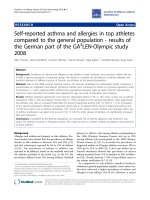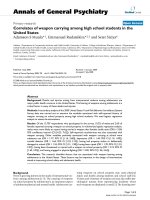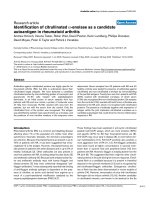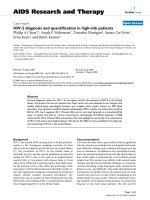Báo cáo y học: "omparison of ankle and subtalar joint complex range of motion during barefoot walking and walking in Masai Barefoot Technology sandals" pdf
Bạn đang xem bản rút gọn của tài liệu. Xem và tải ngay bản đầy đủ của tài liệu tại đây (264.04 KB, 4 trang )
RESEARCH Open Access
Comparison of ankle and subtalar joint complex
range of motion during barefoot walking and
walking in Masai Barefoot Technology sandals
Sophie Roberts
1*
, Ivan Birch
2
, Simon Otter
3*
Abstract
Background: Masai Barefoot Technology (MBT, Switzerland) produce footwear which they claim simulate walking
barefoot on soft undulating ground. This paper reports an investigation into the effect of MBT sandals on the
motion of the ankle and subtalar joint complex during walking.
Methods: Range of motion data was collected in the sagittal, frontal and transverse plane from the ankle and
subtalar joint complex from 32 asymptomatic subjects using the CODA MPX30 motion analysis system during both
barefoot walking and walking in the MBT sandal. Shod and un-shod dat a were compared using the Wilcoxon
signed ranks test.
Results: A significantly greater range of motion in the frontal and sagittal planes was recorded when walking in
the MBT sandal (p = 0.031, and p = 0.015 respectively). In the transverse plane, no significant difference was found
(p = 0.470).
Conclusions: MBT sandals increase the range of motion of the ankle and subtalar joint complex in the frontal and
sagittal planes. MBT footwea r could therefore have a role to play in the management of musculoskeletal disorders
where an increase in frontal and sagittal plane range of motion is desirable.
Background
With the gr owth in the health an d fitness industry,
sports footwear has shown te chnological advances and
diversification. The introduction of footwear such as the
MBT shoe (manufactured by Masai Barefoot Technolo-
gies) is an example of this diversification. MBT have
based t heir shoe design on observations o f the Masai, a
semi-nomadic tribe from Africa who are well known for
their posture and for walking long distances on uneven
terrain. The MBT shoe constructio n is based on a mid-
sole pivot with a rounded sole in the anterior-posterior
direction, and a soft heel pad. It is claimed that the
effect of the angled soft sole not only creates anterior/
posterior facilitation of movement, by purposefully
creating medial and lateral instability in the shoe [1].
According to Romkes et al [2], MBT shoes have been
used to treat foot problems such as hallux valgus, pes
planus, heel and tendo-achilles pain as well as circula-
tory problems. Nigg e t al [3] found that MBT shoes
may be useful as a training device for stability and mus-
cle strengthening adding another dimension to their use.
However, New et al [4] and Nigg et al [3] found that
subjects from many o f the studies conducte d using
MBT shoes received an instruction session in which
they were taught how to use the shoes correctly by a
qualified i nstructor and given a long training period to
acclimatise to the shoes. As such there remains debate
as to whether the reported changes in gait were as a
result of the MBT shoe or the professional instruction
in gait and posture the subjects received and the train-
ing period they had [4].
Nigg et al [3] described that an increase in the angle
of ankle dorsiflexion in MBT shoes was evident com-
pared to a standard tra ining shoe. Vernon et al [5] also
reported subjects exhibited significantly higher maxi-
mum dorsiflexion angle at the ankle joint when wearing
* Correspondence: ;
1
Outpatients Department, Parkside Hospital, 53 Parkside, London, SW19 5NX,
UK
3
University of Brighton, School of Health Sciences, 49 Darley Rd, Eastbourne,
BN20 7UR, UK
Full list of author information is available at the end of the article
Roberts et al. Journal of Foot and Ankle Research 2011, 4:1
/>JOURNAL OF FOOT
AND ANKLE RESEARCH
© 2011 Roberts et al; licensee BioMed Central Ltd. This is an Open Access article distribu ted under the terms of the Creative Commons
Attribution License (http://creativecom mons.org/licenses/by/2.0), w hich permits unrestricted use, distribution, and reproduction in
any medium, provided the original work is properly cited.
MBT shoes. However, it should be noted that in both
these studies, the markers for the motion analysis sys-
tem used to detect movement were placed on the outer
surface of the shoe and therefore their ability to indicate
ankle dorsiflexion could be disputed. Therefore, the
scientific evidence for the clinical use of the MBT shoe
has yet to be presented in the literature, in particular
the changes in function of the ankle and subtalar joint
complex between barefoot walking and walking in the
MBT shoe claimed by the manufacturers. This study
was designed to establish whether there was any affect
of the MBT shoe on human locomotion, in particular to
identify what difference s there are between the range of
motion of the ankle and subtalar joint complex of the
foot during walking in an MBT shoe compared to bare-
foot walking.
Methods
Participants
A total of 32 healthy subjects between the age s of 18
and 35 were re cruited and provided with informed writ-
ten consent to participate in the study from the staff/
student population at the University of Brighton. The
criteria for inclusion and exclusion used in the subject
selection process are shown in Table 1. Ethi cal approval
was granted from the University Of Brighton School Of
Health Professions Ethics Committee. Data were col-
lected in the School Of Health Professions Human
Movement Laboratory using the CODA mpx30 active
marker motion analysis system (Charnwood Dynamics,
Leicestershire, UK).
Data collection
The first set of data was collected with participants
walking barefoot. The CODA measurement framework
was aligned so that Y-axis was anterior/posterior, the X-
axis was medial/la teral and th e Z -axis was vertical. The
marker placement model used for the current study was
based on the model reported by Birch and Deschamp
[6]. To enhance the anatomical reliability of marker pla-
cement, an MBT sandal (see Figure 1) was used for data
collection so the active markers for the CODA system
could be placed directly on the anatomical landmarks of
each subject and not estimated on the outside of the
shoe. According to the MBT manufacturers the unique
strap system of the sandal cradles the whole foot provid-
ing the same function as the MBT shoe [1]. The appro-
priate size MBT sandal was selected for each subject
using the MBT shoe fit guidelines and the subjects were
invited to wear these for 20 minutes to familiarize them-
selves w ith the sandal. The CODA sensors were placed
on the anatomical landmarks detailed in Table 2.
Motion data were collected from each subject while
walking on a 10-metre walkway with the CODA sensor
unit positioned at each end. A 10 Hz filter was applied
to all data.
Statistical analysis
Asinglemid-gaitfootstepwasselectedfromeach
data set; only the right foot was studied owing to t he
complexity of the marker placement model used. A
co-ordinate transform was applied u sing the CODA
software. The fibula head, medial and lateral malleolus
markers were used to determine the frontal, sagittal
and transverse motion from which calcaneal motion
could be measured. Calcaneal motion data measured
relative to the leg was exported into Microsoft Excel
(Microsoft Corporation, Redmond, WA, USA). These
data were then cleaned for outliers and the range of
motion was calculated for each subject by subtracting
the minimum angle recorded from the maximum
angle. Data were analysed using SPSS version 15 (SPSS
Inc Chicago, IL, USA). Shod and un-shod d ata were
compared using the combination of graphs, descriptive
statistics and the Wilcoxon signed ranks test for statis-
tical significance.
Results
The range of motion was calculated for the subtalar and
ankle joint complex in the frontal, sagittal and trans-
verse planes during one footstep using the CODA
MPX30 (Figure 2). Overall, there was an increase in the
range of motion in all three planes of motion from
Table 1 Inclusion and exclusion criteria
Inclusion Female participants must fall within shoe size 4 - 7
Male participants must fall within shoe size 7 - 10
18 and 35 years old
Healthy and injury-free
Exclusion Pain or dysfunction in the lower limb or have done for the
last 6 months, which may affect their ability to ambulate
Previous use of an MBT shoe
Figure 1 MBT sandal used in the study.
Roberts et al. Journal of Foot and Ankle Research 2011, 4:1
/>Page 2 of 4
walking barefoot to walking in an MBT sandal. The
range increased more in some planes than others, with
the greatest increase in the sagittal plane. However, a
minority of subjects clearly demonstrated a decrease in
range of motion. Mean, standard deviation and range of
data are illustrated in Table 3 with an increase in the
mean values in range of motion from walking barefoot
and walking in the MBT shoes in all three planes of
motion being noted. Larger standard deviations were
noted in the MBT sandals in the frontal plane compared
to the two other planes.
The range of frontal and sagittal plane motion was
significantly higher when wearing MBT sandal com-
pared to walking barefoot (frontal p = 0.031, sagittal
p = 0.015). However, for the transverse plane, although
the mean range of motion was higher when wearing the
MBT sandal than when walking barefoot; this difference
was not statistically significant (p = 0.470).
Discussion
The increase in sagittal range of motion on walking in
the MBT sandal in our study could be attributed to the
rounded sole design of the sole of the MBT footwear.
This sole design may lead to increased dorsiflexion of
the ankle and subtalar joint complex at initial contact
followed by an increase in plantarflexion during the pro-
pulsive phase due to the rounded ant erior edge of the
sole. Movement of the ankle and subtalar joint m ove-
ment during stance phase would be encouraged by the
rounded sole creating inertia. This could perhaps
increase range of motion through the ankle and subtalar
joint complex in the sagittal plane compared to walki ng
barefoot on a flat surface and would possibly explain the
results found in this study.
Furthermo re, the d esign of the MBT shoe creates an
uneven surface for the foot by using low density ma teri-
alsaspartofthesoleconstruction.Therefore,an
increase not only in the sagittal plane movement but
also frontal plane movement of the ankle and subtalar
joint could be expected, and may explain our findings of
a statistically significant increase in the range of motion
in the frontal plane in the MBT s andal compared to
walking barefoot. In this study, only the total range of
frontal plane motion was measured, rather than the
amount of inversion and eversion. According to Nigg
et al [3], the rotational inversion loading was higher in
an MBT shoe compared to a standard training shoe,
suggesting that the increased range of frontal plane
movement found in this current study may primarily be
in the direction of inversion.
The results of the study demonstrated that although
there was a small incr ease in the range of motion in the
transverse plane , this difference was not statistically sig-
nificant. According to Nester et al [7], although the
ankle is often considered to have little capacity to mov e
in the transverse plane, it is capable of considerable
movement in the transverse plane (greater than 15
degre es). In our study, transverse plane range of motion
varied between 7 and 57 degrees. In terms of differences
between individuals, our data indicated that some sub-
jects demonstrated a decrease in the range of motion
when walking in the MBT sandal. This could have
resulted from the subjects having insufficient time to get
used to the shoes. Equally, some subjects reported feel-
ing highly unstable in the shoes, which may have caused
the ir ankle and subtalar joints to function with a higher
range of motion compared to walking barefoot.
There are conflicting views on the indications for
MBT footwear in the medical community and guidelines
for clinicians need to be implemented s o that the foot-
wear can be appropriately prescribed. The observed
increase in the range of motion at the ankle and subta-
lar joint complex in the MBT sandal could potentially
Table 2 Anatomical landmarks for the CODA marker
placement
Marker 1 Fibular head
Marker 2 Lateral malleolus
Marker 3 Medial malleolus
Marker 4 Lateral calcaneus
Marker 5 Mid calcaneus
Marker 6 Medial calcaneus
0
10
20
30
40
50
60
7
0
front al* sa
g
ittal* transverse
range o
f
motion
(
degrees
)
barefoot
MBT sanda
l
Figure 2 Mean (± SD) ranges of motion when walking barefoot
and in the MBT sandal. *p < 0.05.
Table 3 Descriptive statistics for the range of motion
differences between barefoot and MBT walking trials
Plane Condition Mean SD Minimum Maximum
Frontal Barefoot 26.3 10.6 5.5 45.5
MBT sandal 34.0 15.6 10.9 66.3
Sagittal Barefoot 39.4 15.5 15.1 69.6
MBT sandal 50.6 15.1 22.1 84.0
Transverse Barefoot 35.7 15.1 8.1 58.0
MBT sandal 38.8 17.7 7.0 67.3
Roberts et al. Journal of Foot and Ankle Research 2011, 4:1
/>Page 3 of 4
be beneficial in certain patient groups, particularly in
those where the decreased range of motion in these
joints are putting strain on other parts of the musculos-
keletal kinetic chain. For example, according to Mona-
ghan et al [8], the therapeutic goal for chronic ankle
instability is to re -train muscles to improve control dur-
ing gait, and an MBT sandal may be an appropriate tool
for this. However, if walking in an MBT sandal demands
greater subtalar and ankle joint range of motion than is
available, soft tissue damage may occur. Further
research in specific patient groups needs to be con-
ducted to aid appropriate prescription of the MBT
sandal.
Conclusions
MBT sandals produce a statistically significant increase
in frontal and sagittal plane rang es of motion of the
subtalar and ankle joint complex during gait. However,
transverse plane motion was not significantly altered.
MBT footwear could th erefore have a role to play in the
management of musculos keletal disorders where an
increase in frontal and sagittal plane range o f motion is
considered desirable.
Acknowledgements
We would like to thank MBT for their loan of the MBT sandals for the study
and the participants who assisted with data collection.
Author details
1
Outpatients Department, Parkside Hospital, 53 Parkside, London, SW19 5NX,
UK.
2
Thames Valley University, Paragon House, Boston Manor Road,
Brentford, Middlesex, TW8 9GA, UK.
3
University of Brighton, School of Health
Sciences, 49 Darley Rd, Eastbourne, BN20 7UR, UK.
Authors’ contributions
All authors have made substantial contributions to the conception and
design of the study, acquisition of data, analysis and interpretation of data,
drafting the article and revising it critically for important intellectual content,
and final approval of the version to be submitted. SR carried out the study
design, data collection and write up. IB: assisted in study design, and data
collection/analysis. SO: assisted in data analysis, particul arly the statistical
analysis and also the discussion.
Competing interests
The authors declare that they have no competing interests.
Received: 22 December 2010 Accepted: 2 January 2011
Published: 2 January 2011
References
1. Masai Barefoot Technology. [].
2. Romkes J, Rudmann C, Brunner R: Changes in gait and EMG when
walking with the Masai Barefoot Technique. Clin Biomech 2006, 21:75-81.
3. Nigg B, Hintzen S, Ferber R: The effect of an unstable shoe construction
on lower extremity gait characteristics. Clin Biomech 2006, 21:82-88.
4. New P, Pearce J: The effects of Masai Barefoot Technology footwear on
posture: an experimental designed study (dissertation). University of
Southampton School of Health Professions; 2007.
5. Vernon T, Wheat J, Naik R, Pettit G: Changes in gait characteristics of a
normal, healthy population due to an unstable shoe construction
(dissertation). Sheffield Hallam University Centre for Sports and Exercise;
2004.
6. Birch I, Deschamps K: The in vitro reliability of the CODA MPX30 as the
basis for a method of assessing the in vivo motion of the subtalar joint.
J Am Podiatr Med Assoc 2010.
7. Nester C, Van De Linden M, Bowker P: Effect of foot orthoses on the
kinematics and kinetics of normal walking gait. Gait Posture 2003,
17:180-187.
8. Monaghan K, Delahunt E, Caulfield B: Increasing the number of gait trial
recordings maximises intra-rater reliability of the coda motion analysis
system. Gait Posture 2007, 25:303-315.
doi:10.1186/1757-1146-4-1
Cite this article as: Roberts et al.: Comparison of ankle and subtalar
joint complex range of motion during barefoot walking and walking in
Masai Barefoot Technology sandals. Journal of Foot and Ankle Research
2011 4:1.
Submit your next manuscript to BioMed Central
and take full advantage of:
• Convenient online submission
• Thorough peer review
• No space constraints or color figure charges
• Immediate publication on acceptance
• Inclusion in PubMed, CAS, Scopus and Google Scholar
• Research which is freely available for redistribution
Submit your manuscript at
www.biomedcentral.com/submit
Roberts et al. Journal of Foot and Ankle Research 2011, 4:1
/>Page 4 of 4









